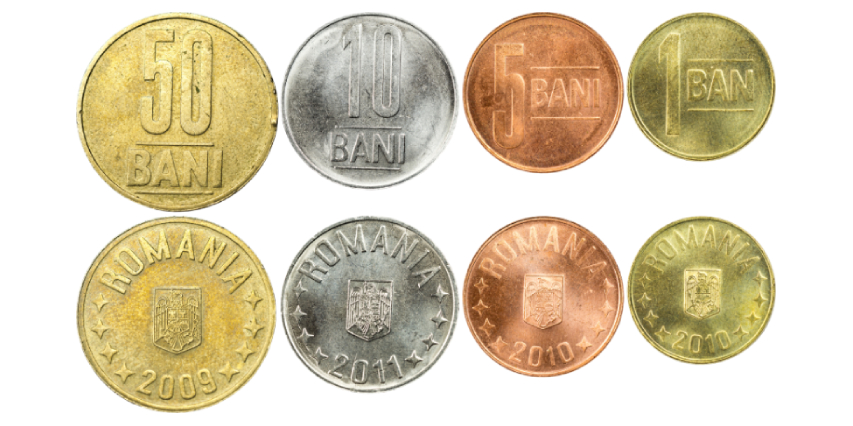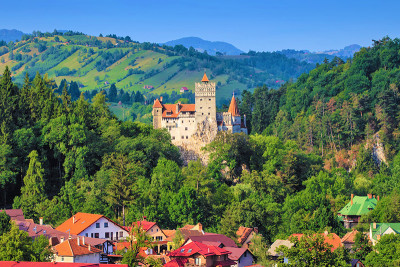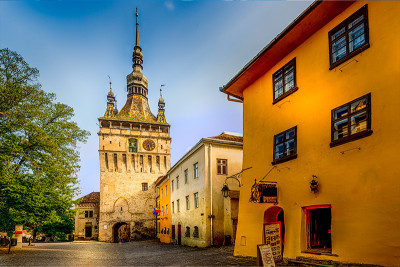If you are planning a trip to Romania soon, you have probably already started to think about something crucial: the Romanian currency. Maybe that is what lead you to this article in the first place, and if that is the case, then you are in luck!
In Romania, the local currency is called the leu (pronounced like “lew” or “loo”), or lei (pronounced “lay”) for plural. Sometimes banks list the currency as RON. The symbol for the money is L. Lei is subdivided into 100 bani, which is also just the word for “money” in the Romanian language. Actually though, Romania is set to adopt the Euro soon. The date keeps getting pushed back, and right now the country is expected to adopt the Euro in 2024. But you are probably planning a trip sooner than that – if that is the case, you will get to use the Romanian lei while they still have it!
The actual physical currency in Romania is both polymer (plastic) bills and metal coins. The bills feel kind of indestructible – you can’t rip them (when you get there, you can try!) and they can’t get soaked. You can get bills worth 1, 5, 10, 50, 100, and 500 lei.
There are four types of Romanian coins: the first is 1 bani (1/100 of a lei) and it is made out of brass-plated steel. It is the smallest of the coins. Next is the 5 bani coin, which is copper-plated steel. It is just slightly larger than the 1 bani coin. Next is the 10 bani coin, which is still just a little larger than the 5 bani coin, and is made out of nickel-plated steel.
Finally is the 50 bani coin. It is about the size of the American quarter and is made of a combination of brass, copper, zinc and nickel. So in total there are four coins, worth 1, 5, 10 and 50 bani.
So, Romania is set to adopt the Euro soon, but the country actually has not had its current leu for all that long.
Romania’s first attempt at creating a national currency occurred in 1860 when Domnitor Alexandru Ioan Cuza tried to create the românul (“the Romanian”), but the Ottoman Empire denied his efforts. When King Carol I came into office, he was able to successfully create the first Romanian currency: the leu.
The currency was created in 1867 and the first leu coin was minted in 1870. The Romanian government saw that the Russian ruble did poorly because it was valued artificially highly, so Romania decided to adopt the gold standard. Taxes and other government dealing were to be completed with gold, and because the leu was still relatively new, Romania often dealt with the currency of other countries as well – especially France’s francs, Turkey’s gold lire, Britain’s sovereigns, and Russia’s imperials.
In 1914, about 20 years before the US would do the same, Romania abandoned the gold standard. This caused the leu to drop significantly in value. During World War II, Romania was an ally of Nazi Germany, and so the leu was tied the Germany’s Reichsmark.
The Reichsmark was used in West Germany from 1924 to 1948. Reich was the official name for the German national state from 1871 to 1945. In 1948 Germany switched to the Deutsche Mark. When the war was over, the value of the leu plummeted so far that the Romanian National Bank had to issue a new leu worth 20,000 of the old lei.
In August, 1947, the Romanian government decided that something had to be done to help their devalued currency. The solution that was decided upon was known as the “marea stabilizare” or “The Great Stabilization.” This was a revaluation of the currency and it occurred without any advance notice. 20,000 old lei was now worth 1 new leu, but there were limits as to how much money people could convert.
There was about 48.5 billion old lei in circulation, and only half of it was converted into the new lei. To put this all into perspective, 1 US dollar was worth about 150 of the new lei in 1948. This revaluation had the greatest effect on the middle and upper classes.
In 1952, another attempt to revaluate the Romanian currency was undertaken. This occurred once again without warning. This time, there was not a set exchange rate to revaluate the currency, but a variety of rates depending on the type of currency – i.e., cash, bank deposits, debts, etc.
From 1970 to 1989, under the communist regime, the government fixed the exchange rate by law. This made it illegal for private actors to buy or sell foreign currency, and even illegal to possess foreign currency, with a possible prison sentence of up to 10 years.
This created a surplus of money and resulted in continued economic decline. This ultimately created a supply side crisis and in 1980 a partial food ration was implemented in the country. By 1987 a full food ration was in place for all the basics. This contributed to great discontent throughout the country with communist leader Ceausescu, and ultimately contributed to his ousting in 1989.
After the fall of communism in Romania, in the 1990s there was high inflation, even as high as 300% per year in 1993. The Romanian lei’s peak value was reached in 2003 when 1 euro was worth a whopping 40,000 lei – and remember, this was nearly 100 years after the revaluation happened where 20,000 lei was suddenly worth 1 leu.
In 2005 another revaluation occurred, where 10,000 lei (ROL) was worth 1 new leu (RON). For about a year and a half, both the old and the new lei were used, creating a bit of confusion. Ultimately, this allowed the lei the appreciate and become more competitive with other European currencies.
Now it is expected that Romania will adopt the Euro, which will likely further boost the Romanian economy.

 ES
ES
 IT
IT
 DE
DE
 FR
FR


